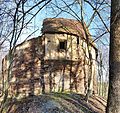Dryfels Castle
The Dryfels castle was located in the city of Berga / Elster in the district of Greiz in Thuringia .
location
In the Middle Ages, a castle on a mountain spur , which juts steeply into the valley of the White Elster from the east , secured and controlled the river crossing of a road running in east-west direction, which connected the Orlatal around Auma with the Muldental of Zwickau . In the past, a wall to the east secured the location.
history
A knight of Berga was known to the lords of Lobdeburg as early as 1225. The first message about Berga an der Elster is registered in the document from 1216 according to Dobecker, II. 1718. In a document from 1310, the noble free Otto von Lobdeburg-Berga appeared as a landgrave witness. As a result of the Vogtland War , the complex (the castle) came to the Landgrave of Thuringia in 1358. In 1378 the castle was given to Heinrich the Red, Vogt von Weida, as pledge. In 1445 the Wettins received the castle. Later the Albertine line Saxony-Zeitz was shown. 1760 Construction of Dryfels Castle on the remains of the castle. Before and in GDR times it was a good. A fire in 1994 resulted in a structural closure for the previously well-preserved and economically stable complex. In 2012 the castle was demolished.
The construction time of the palace complex, which was built on three rocks, can be dated back to the 12th century, remnants of the fortified knight's castle from the 13th and 14th centuries are partially preserved in the fortification walls. The foundation of the castle goes back to the Lobdeburger, who wanted to create a counterpoint to the rule of the bailiffs of Weida. In 1358 the Landgraves of Thuringia took over the complex. In 1373 it was pledged by Heinrich the Red, Vogt von Weida. In 1427 he finally got it back. In 1445 the Wettins got them back.
In 1592 the ownership of the electoral chamber and mountain ridge in Dresden was handed over to Daniel von Watzdorf . The von Watzdorf family is recorded as the owner until 1870. The last member of the family was Bernhard von Watzdorf, who was Minister of State at the court of Grand Duke Karl Alexander of Saxe-Weimar. Until 1875 the castle belonged to Richard Hermann from Zeitz, who in 1875 sold it to Ernst Semmel, the son of the district administrator and secret councilor Moritz Semmel from Gera. Ernst Semmel was elected as a community representative and sold the castle in 1909 to Captain Toppius, who had already worked as administrator of the castle property. In 1938 Ludwig Scharpenseel, who had previously sold his shares in the Schlegel-Scharpenseel brewery , acquired the property and had the property and the outdoor facilities completely renovated.
On September 10, 1945, the Scharpenseel family was expropriated without compensation and fled to Sichtigvor . She lost the manor and the associated lands with a total size of 239 hectares. The facility was outsourced or used to furnish the emergency accommodation for expelled Germans from Central and Eastern Europe . At the same time an agricultural school was established in the castle. At the end of the 1950s, this was outsourced and the state-owned Gut Meilitz took over legal ownership. The stables were converted to fattening pigs. With the " Wende ", the castle became the property of Weigl Holding. On March 8, 1994, the roof of the tenant house built in 1760 burned. The fire and the extinguishing water caused considerable damage to the walls. At the end of 2011 / beginning of 2012, large parts of the castle ruins were demolished for traffic safety reasons . The foundation walls and the castle cellar were preserved.
particularities
Parts of the enclosing walls are still equipped with visible loopholes . On the southwest side, a walled-in gate indicates the original entrance, which was later relocated to the east. In the middle of the complex, the round keep , which was demolished in 1767, once stood on a rock . It is said to have been 45 meters high and a wall thickness of 3 meters. A stable building resembled a chapel . Considerable alterations blurred many testimonies.
Fragment of a sun brick
Web links
- Berga Castle on April 25, 2010 on YouTube
- Berga Castle on August 2, 1914 and 97 years later the demolition of the castle on YouTube
- Berga Castle on January 15, 2012 on YouTube
Individual evidence
- ^ Wolfgang Kahl: First mention of Thuringian towns and villages. A manual. Rockstuhl Verlag, Bad Langensalza 2010, ISBN 978-3-86777-202-0 , p. 29.
- ↑ Ilse Blam, Klaus Blam, Frank Reinhold: Berga an der Elster-From the market to the city . 1st edition. Cebulon-Verlag, Düsseldorf 1993.
- ↑ Thomas Bienert: Medieval castles in Thuringia . Wartberg-Verlag, 2000, ISBN 3-86134-631-1 , p. 94/95
- ↑ Michael Köhler: Thuringian castles and fortified prehistoric and early historical living spaces . Jenzig-Verlag, 2001, ISBN 3-910141-43-9 , p. 87.
- ↑ Michael Köhler: Thuringian castles and fortified prehistoric and early historical living spaces . Jenzig-Verlag, 2001, ISBN 3-910141-43-9 , p. 87-88 .
- ↑ Thomas Bienert: Medieval castles in Thuringia . Wartberg Verlag, 2000, ISBN 3-86134-631-1 , p. 94-95 .
- ↑ Bergaer Zeitung 8/1909
- ↑ Katja Grieser: Only rudiments of the Berga castle left. In: Ostthüringer Zeitung. February 9, 2012, accessed August 19, 2012 .
Coordinates: 50 ° 45 ′ 23.8 " N , 12 ° 9 ′ 54.3" E








